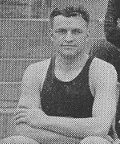Bill Dudack (1917-1921)
"You newspaper guys have overlooked a great story," wrote a letter to the editor in the Washington Times in 1921. "Bill Dudack is the greatest athlete in the country today."
"Did you never hear of a guy starring in three sports, a three-letter man, with two broken legs and typhoid fever? No. Of course you didn't. Now that's Bill Dudack. Two years ago he broke his leg playing baseball. Then it got well, and he went right along and played basketball that winter. And then the next year in football he broke the other leg. Then that one got well, and he played basketball that winter. Then last summer Bill Dudack got typhoid fever. And got over it. And right now he is playing the greatest game of basketball in his life with two broken legs and typhoid fever. How's that for a story?"
The letter came from Dudack's old roommate, Tommy (Zube) Sullivan, reflective of Dudack's three letter sports at Georgetown, interrupted by service in World War I. While not playing, Dudack was a volunteer coach with the Georgetown Prep teams, which were located on the campus until 1919. Coaching became his livelihood, even if his stay as a coach for Georgetown was a short one.
After graduating from the College in 1921, Dudack followed his football coach west, where coach Albert Exendine worked in Tulsa in the off-season. There, Dudack became a high school coach before returning to Washington in the mid-1920's to go to law school and coach at Prep. In 1929, he received his degree and was prepared to begin a law career, but the loss of Elmer Ripley to Yale led Georgetown officials to hand the reins to Dudack for the 1929-30 season. Despite a senior-laden team, the Hoyas finished 13-12, described by one contemporary account as a "powerful but erratic" season. Dudack left after the season and moved to New York.
"I remember when Bill and I were at camp during the war," wrote Sullivan in the 1921 article. "Bill was selected to referee the biggest basketball game of the year. And he did and proved to be a great basketball official. He made such a hit that the general called him up and shook hands with him and said he wanted to meet him. Now Bill Dudack is going to make some college a good coach some day."
Except it would be a high school, not a college. In 1942, Dudack accepted a teaching position at LaSalle Military Academy on Long Island, where he became a coach, athletic director, and mentor to three generations of cadets.
Bill Dudack died in 1991 at the age of 94, having coached for nearly six decades.
| Season | GP | GS | Min | FG | FGA | % | 3FG | 3GA | % | FT | FTA | % | Off | Reb | Avg | PF | Ast | Blk | Stl | Pts | Avg |
|---|---|---|---|---|---|---|---|---|---|---|---|---|---|---|---|---|---|---|---|---|---|
| 1917-18 | 10 | 24 | 2.4 | ||||||||||||||||||
| 1918-19 | 4 | 20 | 5.0 | ||||||||||||||||||
| 1919-20 | 8 | 26 | 3.3 | ||||||||||||||||||
| 1920-21 | 14 | 42 | 3.0 | ||||||||||||||||||
| Totals | 36 | 112 | 3.1 |
